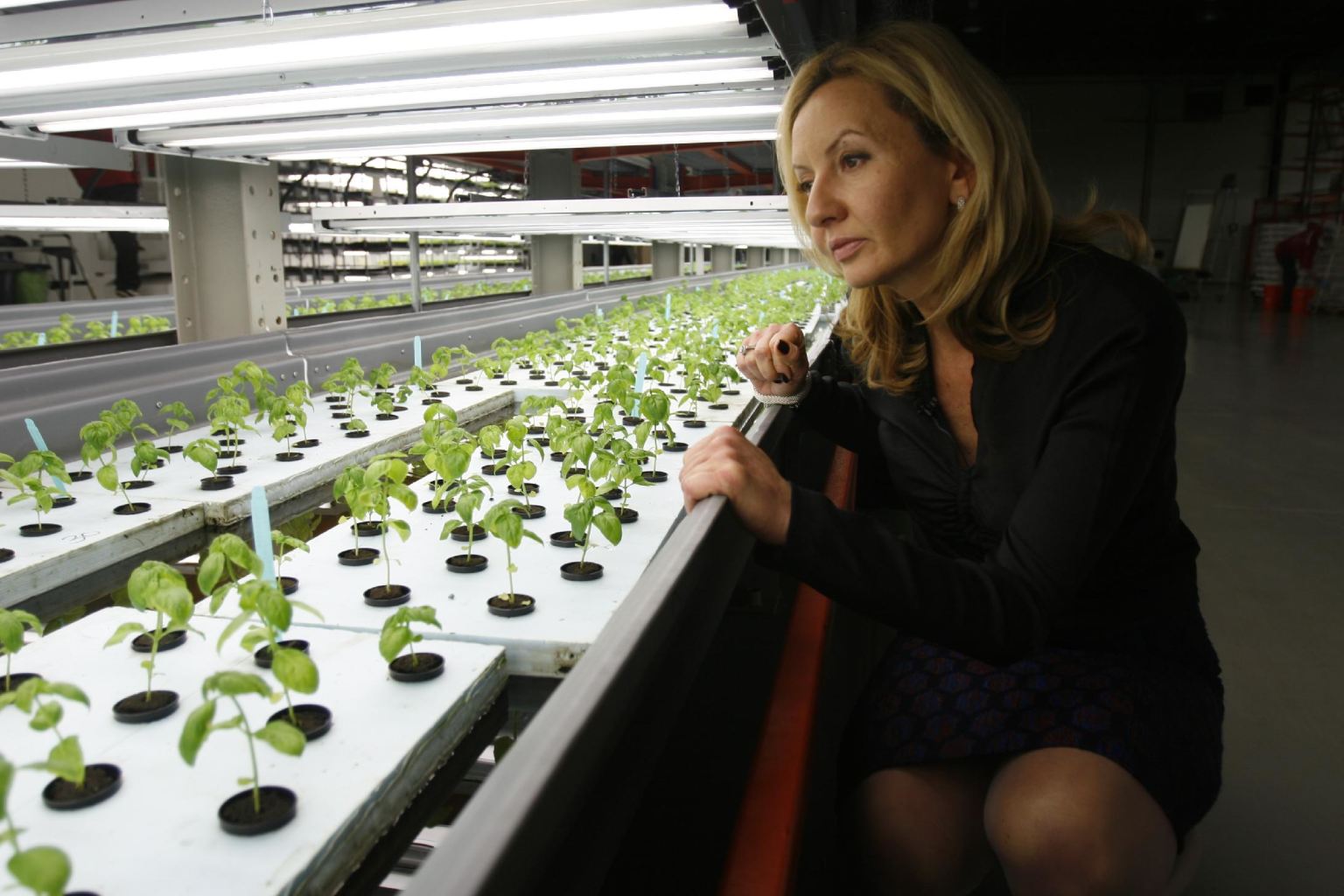
Now one facility, FarmedHere LLC in suburban Chicago,
is attempting to take indoor warehouse farming to the "mega farm"
level, in a region of the country known more for its massive hog, corn
and soybean farms than for crops of boutique greens.
Here's a run-down on the trend, this farm — and the challenges it and other indoor farms face.WHAT ARE THESE FARMS LIKE?
In Chicago, Milwaukee and other urban areas, entrepreneurs have taken up residence in vacant buildings that have high ceilings and plenty of space. Often, these are called "vertical" farms because, within the buildings, farmers build tall structures with several levels of growing beds, often lined with artificial lights. With so much vacant space available, the cost of the property is often cheap, to buy or rent, though the power needed to run these facilities often is not.
Elsewhere, growers are incorporating greenhouses and natural light into their models — sometimes on rooftops, or in large fields.
Though farmers are experimenting with all kinds of crops, most have
had success growing greens — herbs, various types of lettuce and
"microgreens," edible plants, such as beets and sunflowers, which are
harvested when they are young and used like sprouts in salads and
sandwiches."Aquaponic" farms, which also raise tilapia and other fish, use water circulated to the plants that is fertilized with the fish excrement. Often, these farms also sell the fish to grocers or restaurants.
HOW IS FARMEDHERE DIFFERENT?
"It's different here than I've seen anywhere else, just the size, the sheer scale of it is very unique," says Maximino Gonzalez, the master grower at FarmedHere LLC.
The company, based in Bedford Park, Ill., is finishing the first of four phases, with plans to expand by the end of next year to 150,000 square feet of vertical growing space.
Already, they say they are the largest vertical farm in the country, a claim experts who monitor the field believe to be true. The farm supplies local grocery with fresh basil, arugula and other greens.
Right now, the farm has two large structures with five to six levels of massive growing beds that are lit with fluorescent lighting.
One structure, where basil is grown, is "aquaponic." Water underneath the plants — which rest in cutouts in styrofoam "floats" — circulates through a system from the plants to two large tanks of fish. The other structure, where arugula is grown, is "aeroponic," with water misters underneath that spray the plants' exposed roots.
A third structure is under construction and will be completed soon, owners at FarmedHere say.
WHAT'S THE ROUTINE LIKE AT FARMEDHERE?Workers plant the seeds and grow seedlings on racks, then transfer into the growing systems.
After about a month, the crops — certified as "organic" by the USDA — are harvested and packaged by about a dozen workers in a cooling room at the facility. Early the morning after the harvests, workers use two vans to deliver those greens — mainly basil and arugula right now — to grocers in Chicago and suburbs, including Whole Foods and Mariano's Fresh Market locations.
CEO Jolanta Hardej calls it "on-demand farming."
"Let's say that the demand is suddenly for various types of arugula or various types of mixed greens, or mini greens," she says. "We could change the whole system ... and pretty much within the next 14 to 28 days, we have a full grown plant, whatever the market requires."
WHAT ARE THE CHALLENGES?
The biggest stumbling block for facilities like these remains power — the amount of electricity to run the lights that help the plants grow. Heating these massive spaces also can be costly.
Experts in the field say this will also be a big challenge for FarmedHere, because of its size.
A few other indoor farms in Wisconsin and Chicago have gone out of business, or are struggling to stay open.
"It's hard to get there for sure," says Sylvia Bernstein, an aquaponics supplier based in Boulder, Colo., who blogs about the trend. "There are a lot of people working on it."
Some growers are experimenting with solar, wind and methane as ways to generate the power. Others are supplementing artificial light with natural greenhouse or window lighting.
Hardej says FarmedHere is looking at methane options. Though she declined to elaborate for competitive reasons, she said the eventual goal is for the facility to be self-sustaining.
Many believe indoor farms that rely on artificial light will become even more viable as energy-efficient LED lighting improves and becomes more affordable.
But Dickson Despommier, a retired Columbia University microbiologist
who wrote the book "The Vertical Farm: Feeding the World in the 21st
Century," says powering farms is still the biggest hurdle for the
industry — one that many farmers are often reluctant to talk about
publicly."A lot of them will tuck their head under their wings and say, 'Wait and see,'" he says, noting that he's anxious to see large indoor farming models in Japan that use both artificial and natural light. He says entrepreneurs in Germany also are experimenting with flickering lights that use less power but still emit enough light to grow plants.
"In another two or three years, this will shake out," Despommier says. "And we'll see which systems work, and which don't."

No comments:
Post a Comment